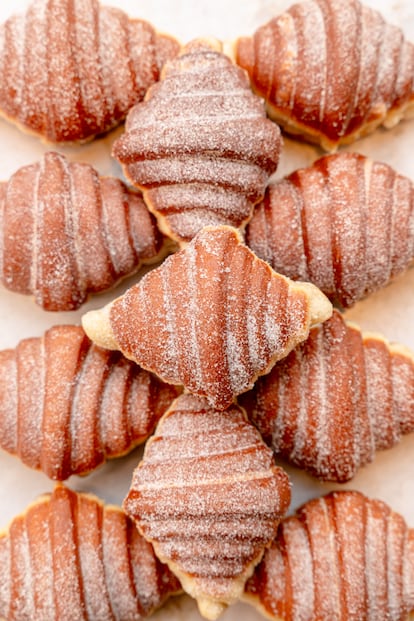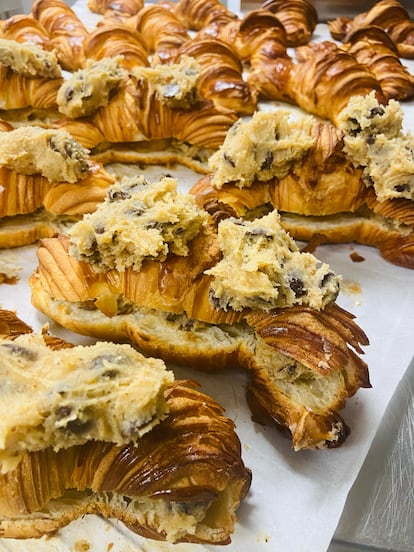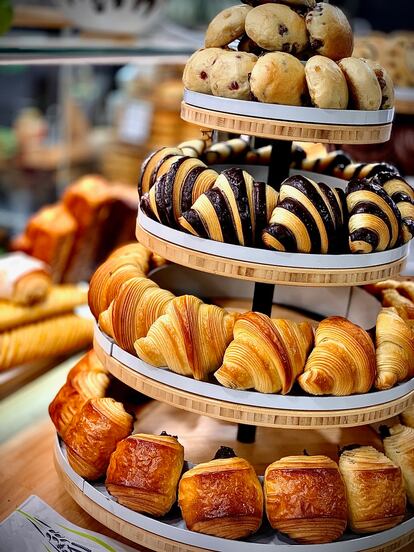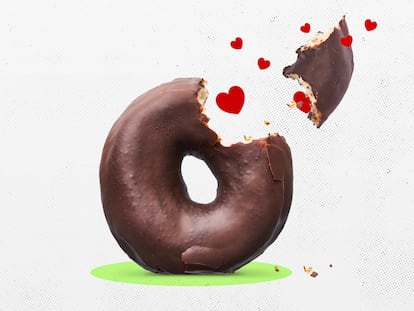From ‘crookies’ to flavored versions: The French croissant reinvents itself to battle American snacks and attract Gen Z
In a survey published by the consulting firm Strateg’eat, 38% of young people in France prefer cookies over other sweet options like croissants and pain au chocolat

Next to the Eiffel Tower, it is perhaps France’s most emblematic monument: the butter croissant is a must in the country’s bakeries. The ideal texture is crispy on the outside and spongy on the inside, and you can find it at any store at relatively affordable prices. But in recent years, the prestigious viennoiserie, as this type of flaky pastry is known in France, has been overshadowed by the growing success of cookies, doughnuts and other American snacks, and its creators seem intent on continuing to fight for their rightful place among baked goods. For many bakers, the secret to success lies in experimentation and social media impact. Indeed, that has led a neighborhood bakery in Paris to have constant lines of tourists and young people eager to try the crookie, a combination of croissant and cookie dough.
“I did it for fun, I had no pretensions,” the crookie’s creator, baker Stéphane Louvard of Boulangerie Louvard, near the Grands Boulevards, tells EL PAÍS. In recent weeks, production has gone from about 100 units a day to 1,500 and 2,200, after two influencers talked about his crookies on Instagram and TikTok. “Since then, the influx just keeps going up, it’s hard to keep up with what’s been coming at us.” By comparison, they sell about 250 butter croissants every day.
Although the lines started at the end of January, the crookie itself was created in October 2022. “One day we were making cookies and tried putting the dough inside croissants. We liked it and decided to sell some. We’ve always liked them, but now we see a new public coming to look for us, especially tourists, young people and TikTokers from the area. It’s what they call food porn, which sells well on social media, and the latter is what we find really incredible,” says Louvard, still incredulous at the media popularity of his latest creation.

The crookie sells for €5.90, the total of the price of the croissant and cookies. The croissant has uncooked chocolate chip cookie dough, and two flaky layers of baked dough on the outside. “The secret is that the croissant is crispy, while the cookie is almost melted inside,” Louvard confides. “We use top-quality ingredients. There are stores that are selling frozen versions and I know of other bakers who are trying to make their own, even in England and Morocco,” he says. Indeed, some videos with homemade crookie recipes are already circulating on social media.
@seriousfoodfetish The Viral Crookie from Paris but make it at home #crookie #cookie #croissant #paris #baketok #viraldessert #mashup #asmr #fyp
♬ Paris Cafe Music - Relaxing Piano Music Oasis
In a survey published by the gastronomic consultancy Strateg’eat for the Sandwich & Snacking Show, pain au chocolat (or chocolatine, depending on which corner of France you are in) is France’s favorite sweet snack (34%), ahead of croissants, which are in second place (28%). But if we only consider Generation Z data, cookies come out on top among 38% of the youngest. That figure reflects the growing French passion for American baked goods, which are gaining ground against viennoiseries.
“We’re seeing that viennoiseries will always have a place in the hearts of the French, although less so in the hearts of Generation Z, especially those under 25. Is this the end of French pastry? I don’t think so, but it does force us to have a variety of products in bakeries,” explains Nicolas Nouchi, founder of Strateg’eat. He believes that the “will to exist on social media” through notoriety is a necessity for retailers.

In a country where the majority still does not eat breakfast away from home, offerings of savory or cream-filled croissants are extras; for the most orthodox, they are a form of blasphemy. However, the presence of these products has continued to make an impact after the French haute pâtisserie opted to refresh its croissants and pains au chocolat. In recent years, the novelties have kept coming: from Philippe Conticini’s giant croissant and pain au chocolat (about €30 per unit), to Cédric Grolet’s beignet croissant, sold for €5 at his store in Ópera ‘Cédric Grolet Café. Grolet mesmerizes social media with the preparation of his recipes and famous guests to his workshop like Rosalía and Pedro Alonso. “The croissant is our foundation and star product. The chef has proposed a new version combining it with a fritter to add novelty and an urban influence,” Grolet’s team emphasizes. “We see real enthusiasm from viennoiserie customers. They appreciate simple creations, full of techniques and especially full of meaning. In our new café, we are seeing a new, younger clientele.”
Outside Paris, experiments are also swooping in, with the added challenge of winning over more conservative local consumers: Louis Tortochot, who was voted best baker in France in 2019, made a name for himself in 2011 with his flavored croissants and eventually set up a croissant bar in his two bakeries in Dijon, Du Pain pour demain. There, customers can fill their croissants with praline, raspberry, pistachio and other creams right in the store. “The croissant (€1.30) makes up a third of pastry sales, another third would be the pain au chocolat and the third [are] flavored croissants (€2.10), of which we sell about 600 a day. Not bad for a city like Dijon,” says Tortochot, who notes that this trendy product does best with those under 45 years old. Although he started this project before the boom on social media, Tortochot does not mind its influence on consumers. “We are a zapping generation. We like to be stimulated with novelties and [then] move on to something else. That’s why you have to have options. In this society, you either move or you die,” he says.

In Bordeaux, Louis Lamour is part of the new wave of bakers who are daring to test the limits of traditional recipes. In his two stores, which have constant lines of customers, he offers daily Croichoc (€2,50), with chocolate inside, and Beyrouthin (€2.50), a croissant filled with goat cheese and Asian spices. On weekends, he adds the Croistache (€3), which has pistachio cream, to the menu. “Moving beyond the traditional croissant, which is still the most interesting product, allows us to communicate better and give value to our craftsmanship. The customer’s perception is that the traditional croissant should not be expensive because they consume it often, they do not appreciate the value of the craftsmanship despite the fact that there are very significant costs for raw materials and labor,” says Lamour. He notes that many French bakeries resort to frozen croissants, charging a price very similar to that of croissants made from scratch, as in his case (€1.30). “For us, seeking originality is fun; it’s a challenge, but above all it allows us to make people aware that they are eating a unique product. The customer is more willing to pay more for it,” he emphasizes.
Social media has also marked a before and after. “I’m not particularly a fan of the transformation imposed on us by social media, but as an entrepreneur, [I know that] it is a dominant means of communication. And these products attract a younger clientele and foodies that you can’t attract with a baguette or a buttery croissant, no matter how good and pretty it is,” Lamour laments.
Consultant Nicolas Nouchi is quick to describe this as a “micro-trend,” which puts more intrepid customers in a delicate position: if they want to try it, they’d better get in line soon, before the crookie is overtaken by the next viral creation.
Sign up for our weekly newsletter to get more English-language news coverage from EL PAÍS USA Edition
Tu suscripción se está usando en otro dispositivo
¿Quieres añadir otro usuario a tu suscripción?
Si continúas leyendo en este dispositivo, no se podrá leer en el otro.
FlechaTu suscripción se está usando en otro dispositivo y solo puedes acceder a EL PAÍS desde un dispositivo a la vez.
Si quieres compartir tu cuenta, cambia tu suscripción a la modalidad Premium, así podrás añadir otro usuario. Cada uno accederá con su propia cuenta de email, lo que os permitirá personalizar vuestra experiencia en EL PAÍS.
¿Tienes una suscripción de empresa? Accede aquí para contratar más cuentas.
En el caso de no saber quién está usando tu cuenta, te recomendamos cambiar tu contraseña aquí.
Si decides continuar compartiendo tu cuenta, este mensaje se mostrará en tu dispositivo y en el de la otra persona que está usando tu cuenta de forma indefinida, afectando a tu experiencia de lectura. Puedes consultar aquí los términos y condiciones de la suscripción digital.
More information
Archived In
Últimas noticias
Welcome to the post-religion era: The idea of Christianity as the absolute truth has become obsolete
‘I thought you would like it’: The risky sexual practice popularized by TV shows and TikTok
The digitalization of tourism: ‘They promise experiences and gave us the worst possible one’
Mexican peso defies uncertainty with forecasts of a new period of stability in 2026
Most viewed
- Sinaloa Cartel war is taking its toll on Los Chapitos
- Oona Chaplin: ‘I told James Cameron that I was living in a treehouse and starting a permaculture project with a friend’
- Reinhard Genzel, Nobel laureate in physics: ‘One-minute videos will never give you the truth’
- Why the price of coffee has skyrocketed: from Brazilian plantations to specialty coffee houses
- Silver prices are going crazy: This is what’s fueling the rally










































